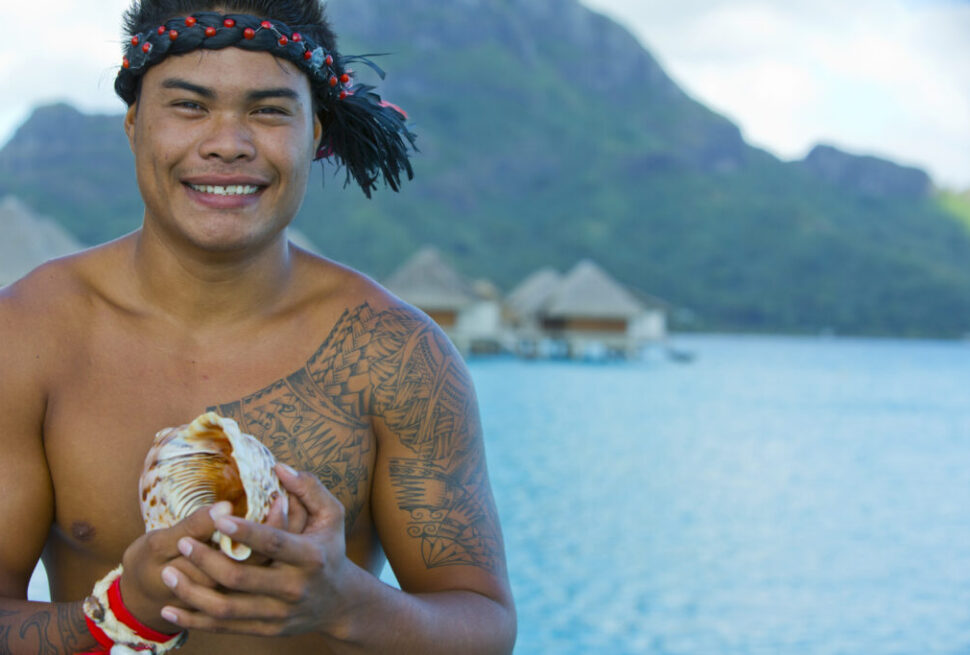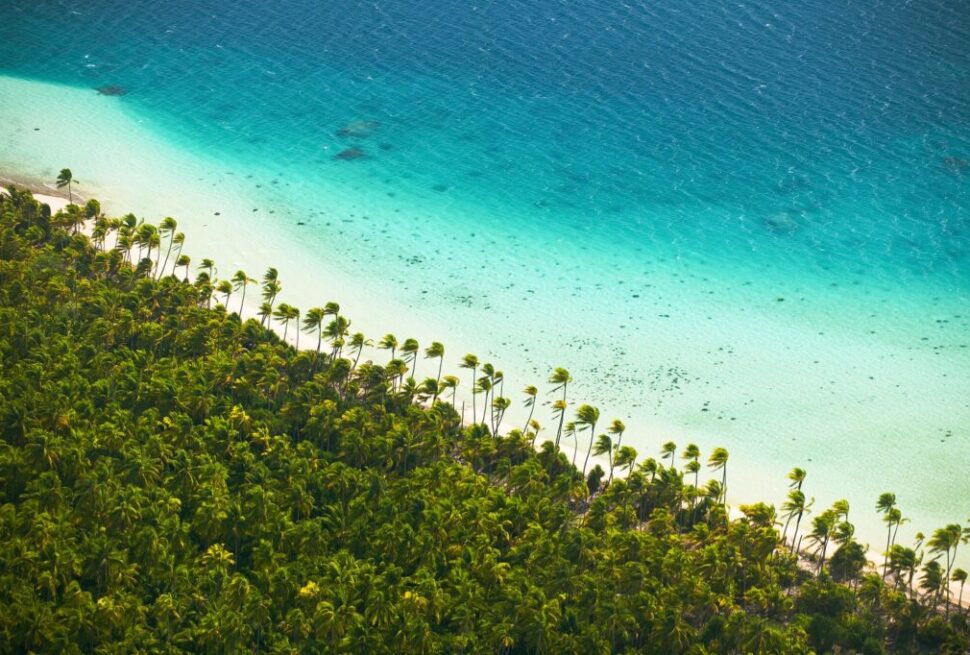A Polynesian invention
Horue in Tahitian, holua in Hawaiian, horu is a notion common to several Polynesian languages which expresses, among other meanings, the depths of the ocean which the hollows of a great wave allow us to catch a glimpse of. This is no doubt why it has today also come to mean by derivation to glide on a breaker and now “to surf”. The term most used today is fa’ahe’e (that is, to make something glide) which had fallen into disuse. ‘Iri fa’ahe’e is used to mean the surfboard. The horue, that Polynesian amusement and pastime, was first described by one of Captain Cook’s lieutenants in Hawaii in 1779. But it was also practised in the archipelago of the Society Islands as witnessed by James Morrison, one of the sailors who deserted the Bounty, in 1788: “For this entertainment, they take a plank of variable length and swim to the start of the swell waiting for a wave to form, sometimes more than a mile out to sea, and lying on the plank on their stomachs they ride the crest of the wave so as to come in with it at an extraordinary speed. Men and women alike excel at this sport and some are even capable of standing upright on their plank.” (1). In a chant of praise passed on by Teuira Henry in his book Tahiti aux temps anciens (Tahiti in Ancient Times), it says that the stretch of water called Maha’ena on the east coast of Tahiti was famous for the practice of surfing, especially around the two shallows known as Pūta’ihani and To’a-tāne, where the superb Hinaraure’a, the wife of the demi-god Turi, excelled and surpassed every champion in this discipline. Her unequalled exploits in this sport earned her the name of Tō’ū’ura-oi-ore (glorious woman of incredible excellence) for her skill in guiding her board, which never steered off course. The boards at the time were made of wood and could weigh more than 60 kilos for sizes approaching 4 metres.
A traditional practice
Just like the other games and entertainments that were played in the water or on the beach such as tōtōie, tītīra’ina, ‘aumoa, or pāuma,the practice of horue was part of the training for young people descended from the ari’i, hiva and toa in their long apprenticeship of navigation: getting to know and better master the winds, swells and currents, taking advantage of the power of the waves and the sea swell to go faster by learning to slide one’s boat most skilfully over the surface of the ocean. With the disappearance of these socio-politico-religious lineages, the people kept these games which they continued to pass on to the younger generations through inter-community competitions. What had been entertaining ways of learning and training for navigation became real sporting disciplines in competitions open to all. In Cook’s time, the Polynesians were apparently already using three different types of board which were manufactured according to precise criteria inherently linked to the skills to be acquired in terms of gliding.
Disuse and renaissance
With the colonisation and evangelisation of the Polynesian islands, surfing fell into disuse and was no longer valued. In the eyes of the new dominant religion, it was not appropriate to waste one’s time on such a game, especially as it was practised almost naked in the water by both men and women. It was not until the 1920s, particularly because of the great impetus it was given by the Hawaiian Duke Kahanamoku, that surfing recovered its place as a recognised sport. That is how a traditional Polynesian practice acquired an international dimension in the years 1950-1960, then becoming a real sport in the following decade before finally developing into a whole lifestyle in the years 1980-90.
Ideal conditions
Almost at the centre of the vastest ocean on the planet, the Polynesian islands are exposed to the powerful swells criss-crossing the Pacific. The surf season never ends.
Not far out from the shore, the depth of the ocean is already several kilometres as the islands are the tops of submerged former volcanoes. With no gradual raising of the sea bed to act as a buffer, the swell breaks violently onto the coasts or the barrier reefs forming the most perfect and most beautiful waves in the world. As well as being crystal clear, the Polynesian waters are known for their warm temperature, ranging between 23° and26°. The large amount of sun in the Polynesian climate is also a great asset with an annual average temperature of approximately 28°.
Surfing all year round
During the winter, powerful depressions in the northern hemisphere, located to the north-west of the Pacific, generate long swells which affect the north and north-west facing coasts of Polynesia, in particular from November to April.
Between June and September, during the southern winter, swells are formed by depressions in the southern hemisphere, near Antarctica and affect the Polynesian coasts facing south and south-east. Finally, swells known as cyclonic swell sometimes affect French Polynesia. Generated by depressions and tropical cyclones in the South Pacific, they are outstandingly powerful. They are sought after by the élite of world and local surfers because of the exceptional surfing conditions they present. Progress in marine meteorology now allows us to have several days advance warning of the arrival of strong swells.
Variety of the waves
With the majority of these high islands encircled by coral reefs, French Polynesia has numerous
”reefbreaks” or reef wave “spots “. Breaking over the barrier reef, these waves are powerful, very deep and perfect for “tube riding”.
Polynesia also has “shorebreaks” in the coastal areas not directly protected by a barrier reef. The waves break either onto beaches forming a “beachbreak”, or onto rocky coasts. Whereas
“reefbreaks” are the preserve of hardened surfers, some “beachbreaks”, principally situated on the island of Tahiti, make ideal places for beginners.
Finally, Polynesia has waves on the shallows. Breaking over these shallows when there is a strong swell, these waves are called “maoti” by the local surfers. Being very powerful, they have in recent times mainly been surfed by “tow-in” or surfers towed by jet skis, and are obviously reserved for experts.
International class locations
Certain surf spots are unmissable top locations in the world of surfing. Near the Hāva’e channel, 70 Km from Papeetē, the legendary Teahupo’o wave owes its fame to its beauty, power and danger too. Each year, at the beginning of May, it is the scene of the battle between the 44 best world surfers during the Billabong Pro.
When there are strong swells, with waves of more than ten metres high, the greatest names in surfing, such as the Hawaiian Laird Hamilton, all rush to surf at Teahupo’o!
Other “spots” have also acquired international fame such as the ”embouchure” (mouth) of Papeno’o on the island of Tahiti, Ta’apuna in Punaauia and Tema’e on the island of Mo’orea.
Famous surfers
As a nation of surfing, French Polynesia is the home of great names in this discipline: Vetea
David,the first Polynesian to win the junior world championship and who was to go on the professional circuit for the next ten years; Arsène Harehoe, French champion in 1983;
Hira Teriinatoofa, world amateur ISA (International Surfing Association) champion in 2004 and Patricia Rossi, European champion in 2000. New generations of champions are coming forward such as Tamaroa Mc Comb, junior world champion in 2008 and Michel Bourez, junior European champion in 2006.
Outside the competition circuit, Polynesian surfers such as Manoa Drollet, Vetea
David, Arsène Harehoe and Raimana Van Bastolaer are renowned for the quality of their surfing, especially on the big waves.
A popular sport and a real “surf culture”
Surfing is one of the most popular sports with the Polynesians. There are an estimated 20,000 regular surfers in the country.
Far beyond a mere leisure sport, surfing is a real phenomenon in this society. A whole economy has developed around this activity: from the manufacturers of surfboards, the “shapers”, to lines of specialist clothing and accessories. Surfing is everywhere, making Tahiti and its islands a real surfing nation.
Throughout the year a multitude of competitions take place.
Increasingly, foreign surfers who are passionate about the sport come on a “surf-trip”. Hiring boats and assisted by local surfer-guides, they set off to discover unexplored or little known “spots” especially in the far-off archipelagos such as the Australes, the Marquises and the Tuamotu.
1) James Morisson, “Journal de James Morisson second maître à bord de la “Bounty”“(Journal of James Morisson, second master of the “Bounty”).
Translated from the English by B. Jaunez. Coll. Published by the Société des Océanistes, N 16, Musée de l’Homme. 1966
The main surf spots
- Tahiti, west coast
Channel from Hāva’e to Teahupo’o; Te Ava ‘Ino Channel, Te Ava Iti and de Vaira’o (Peninsula); Mitirapa; Ti’ama’o; Mara’a; Taharu’u Beach; Sapinus – Pointe des Pêcheurs and Ta’apuna. - Tahiti, east coast
‘Ārue Reef; Lafayette beach; Reef de la pointe Vénus; ‘Āhonu; ‘Orofara; Rocky Point, La Baie; the mouth of the Papeno’o. - Mo’orea
Ha’apiti; Tema’e; the Cook and ’Opūnohu bays ; Beachcomber and ‘Atiha. - Huahine
Fīti’i; Parea and the channel of Ava Mo’a.
The main competitions
- Billabong Pro -Teahupo’o, early May (Teahupo’o – Tahiti)
- Air Tahiti Nui – Von Zipper Trials, end April (Teahupo’o – Tahiti) Ta’apuna Master, September (Punaauia – Tahiti)
- Te Ava Ava Nui Long Board Classic, end December (Papeno’o – Tahiti)




